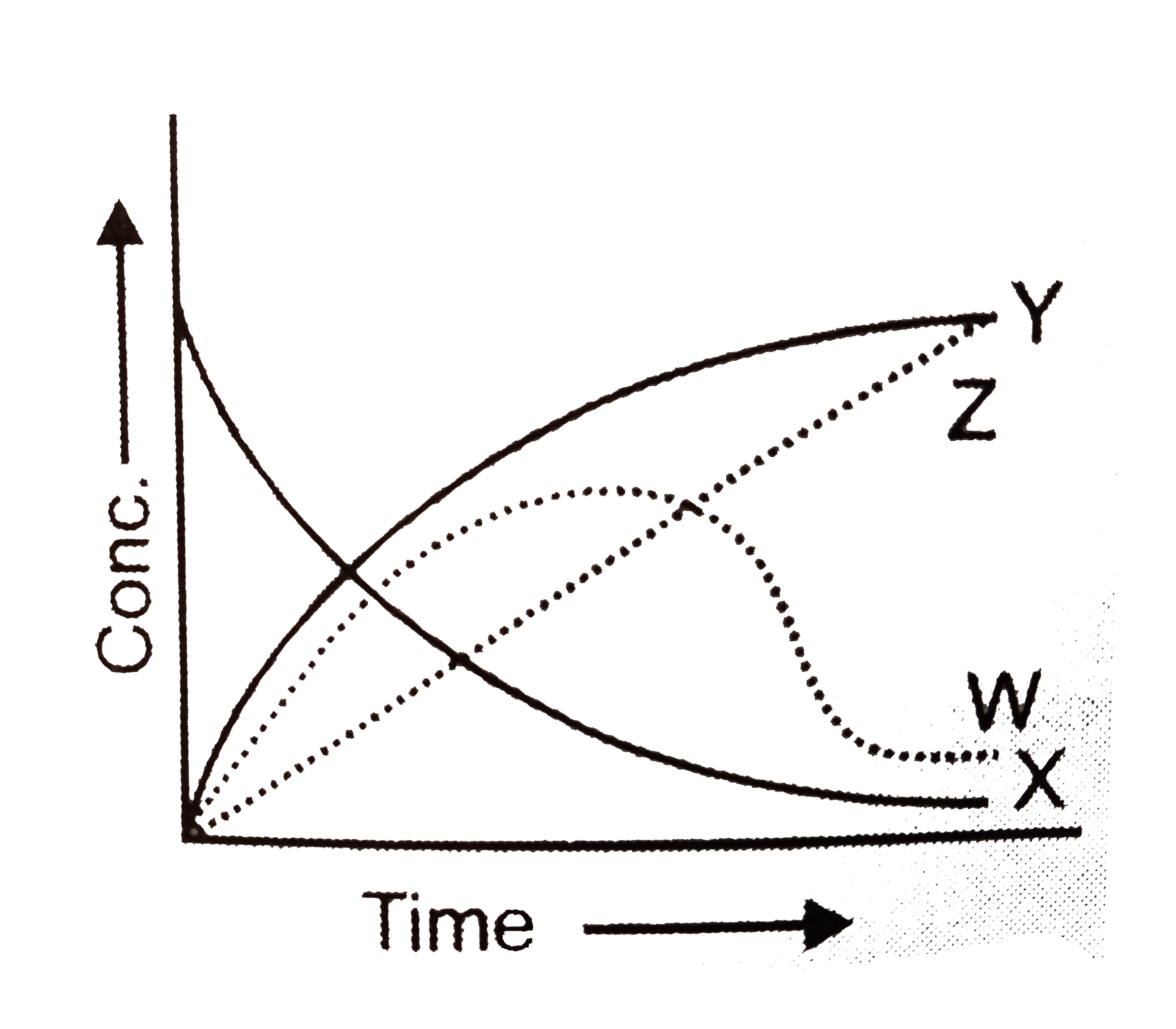The experiment data for the reaction 2A+B2→2AB is
∣∣
∣
∣
∣
∣∣Experiment[A]M[B2]MInitial rate(molL−1s−1)I0.500.51.6×10−4II0.501.03.2×10−4III1.001.03.2×10−4∣∣
∣
∣
∣
∣∣
Write the most probable rate equation for the reacting giving reason for you answer.
Let rate expression be: rate =K[A]m[B2]n
Thus, 1.6×10−4=K(0.5)m(0.5)n…(i)
3.2×10−4=K(0.5)m(1.0)n…(ii)
3.2×10−4=K(1.0)m(1.0)n…(iii)
By eqs. (i) and (ii), n=1
By eqs. (ii) and (iii), m=0
Rate=dxdtK[B2]1
Topper's Solved these Questions
- CHEMICAL KINETICSBook:P BAHADURChapter:CHEMICAL KINETICSExercise:Exercise 1
Explore 2 Videos
- CHEMICAL KINETICSBook:P BAHADURChapter:CHEMICAL KINETICSExercise:Exercise 3A
Explore 2 Videos
- DILUTE SOLUTION AND COLLIGATIVE PROPERTIESBook:P BAHADURChapter:DILUTE SOLUTION AND COLLIGATIVE PROPERTIESExercise:Exercise 9 Advanced Numerical
Explore 12 Videos
Similar Questions
The following data represent for the decomposition of NH4NO2 in aqueous solution.
Time (in minutes), 10,15,20,25,∞
Volume of N2 (in mL), 6.25,9.0,11.40,13.65,33.05,
(a) Show that reaction is of first order.
(b) Calculate velocity constant.
View SolutionFor the reaction, A+B→C+D. The variation of the concentration of the products with time is given by the curve:

View SolutionIf at a particular tempreture, the density of 18M H2SO4 is 1.8gCm−3, calcualte:
(a) Molality,
(b) % concentration by weight of solution
(c ) Mole fraction of water and H2SO4,
(d) Relative decrease in vapour pressure with repsect to H2O solvent assuming H2SO4 almost unionised at this high concentration.
View SolutionFor the hypothetical reaction 2A + B rarr Products following data obtained: |{:("Experiment number","Initial conc of (A)" (mol L^(-1)),"Initial conc of (B)" (mol L^(-1)),"Initial rate mol" L^(-1) s^(-1),),(1,0.10,0.20,3 xx 10^(2),),(2,0.30,0.40,3.6 xx 10^(10^(3)),),(3,0.30,0.80,1.44 xx 10^(4),),(4,0.10,0.40,...,),(5,0.20,0.60,...,),(6,0.30,1.20,...,):}| Find out how the rate of the reaction depends upon the concentration of A and B and fill in the blanks given in the table.
View SolutionThe experiment data for the reaction 2A+B2→2AB is
∣∣ ∣ ∣ ∣ ∣∣Experiment[A]M[B2]MInitial rate(molL−1s−1)I0.500.51.6×10−4II0.501.03.2×10−4III1.001.03.2×10−4∣∣ ∣ ∣ ∣ ∣∣
Write the most probable rate equation for the reacting giving reason for you answer.
View SolutionAnalyze the generalized rate data:
RX + M^(ɵ) rarr Product
∣∣ ∣ ∣ ∣ ∣ ∣ ∣∣Experiment[RX]Substrate[Mɵ]Attaking speciesRateI0.10M0.10M1.2×10−4II0.20M0.10M2.4×10−4III0.10M0.20M2.4×10−4IV0.20M0.20M4.8×10−4∣∣ ∣ ∣ ∣ ∣ ∣ ∣∣
The value of rate constant for the give experiment data is
View SolutionThe rate constant for the reaction A rarr B is 2 xx 10^(-4) mol^(-1) . The concentration of A at which rate of the reaction is (1//2) xx 10^(-5) M sec^(-1) is -
View SolutionFor the elementary reaction 2A + B to 3C , if the rate of appearance of C at time 't' is 1.3 xx 10^(-4)mol L^(-1)s^(-1) , calculate at this time (i) rate of the reaction (ii) rate of disappearance of A.
View SolutionFor the reaction A + B to products, what will be the order of reaction with respect to A and B? {:("Exp",[A](mol L^(-1)),[B](mol L^(-1)),"Initial rate (mol L^(-1) s^(-1))),(1,2.5 xx 10^(-4), 3 xx 10^(-5), 5 xx 10^(-4)),(2,5 xx 10^(-4),6 xx 10^(-5), 4 xx 10^(-3)),(3, 1xx 10^(-3), 6 xx 10^(-5), 1.6 xx 10^(-2)):}
View SolutionThe experiment data for the reaction 2A+B2→2AB is
∣∣ ∣ ∣ ∣ ∣∣Experiment[A]M[B2]MInitial rate(molL−1s−1)I0.500.51.6×10−4II0.501.03.2×10−4III1.001.03.2×10−4∣∣ ∣ ∣ ∣ ∣∣
Write the most probable rate equation for the reacting giving reason for you answer.
View SolutionRate constant of two reactions are given below. Indentifying their order of reaction. (i) k = 6.3 xx 10^(-2) L mol^(-1) s^(-1) (ii) k = 2.8 xx 10^(-4) s^(-1)
View SolutionThe experimental data for the reaction 2A+B_(2)to2AB is given below. Based on the data write the rate equation. {:("[A],mol L"^(-1),[B_(2)]", mol L"^(-1),"Rate, mol L"^(-1)s^(-1)),(0.5,0.5,1.6xx10^(-4)),(0.5,1.0,3.2xx10^(-4)),(1.0,1.0,3.2xx10^(-4)):}
View SolutionFor the reaction A + B to products, what will be the order of reaction with respect to A and B? {:("Exp",[A](mol L^(-1)),[B](mol L^(-1)),"Initial rate (mol L^(-1) s^(-1))),(1,2.5 xx 10^(-4), 3 xx 10^(-5), 5 xx 10^(-4)),(2,5 xx 10^(-4),6 xx 10^(-5), 4 xx 10^(-3)),(3, 1xx 10^(-3), 6 xx 10^(-5), 1.6 xx 10^(-2)):}
View Solutionदो अभिक्रियाओं के दर स्थिरांक नीचे दिये गये हैं: उनकी अभिक्रिया की कोटि पहचानिए।
(i) k=5.3×10−2Lmol−1s−1
(ii) k=3.8×10−4s−1
View SolutionFor the hypothetical reaction
2A+B→ Products
following data obtained:
∣∣ ∣ ∣ ∣ ∣ ∣ ∣ ∣ ∣∣Experiment numberInitial conc of (A)(molL−1)Initial conc of (B)(molL−1)Initial rate molL−1s−110.100.203×10220.300.403.6×1010330.300.801.44×10440.100.40...50.200.60...60.301.20...∣∣ ∣ ∣ ∣ ∣ ∣ ∣ ∣ ∣∣
Find out how the rate of the reaction depends upon the concentration of A and B and fill in the blanks given in the table.
View SolutionThe experiment data for the reaction 2A+B2→2AB is
∣∣ ∣ ∣ ∣ ∣∣Experiment[A]M[B2]MInitial rate(molL−1s−1)I0.500.51.6×10−4II0.501.03.2×10−4III1.001.03.2×10−4∣∣ ∣ ∣ ∣ ∣∣
Write the most probable rate equation for the reacting giving reason for you answer.
View Solution
